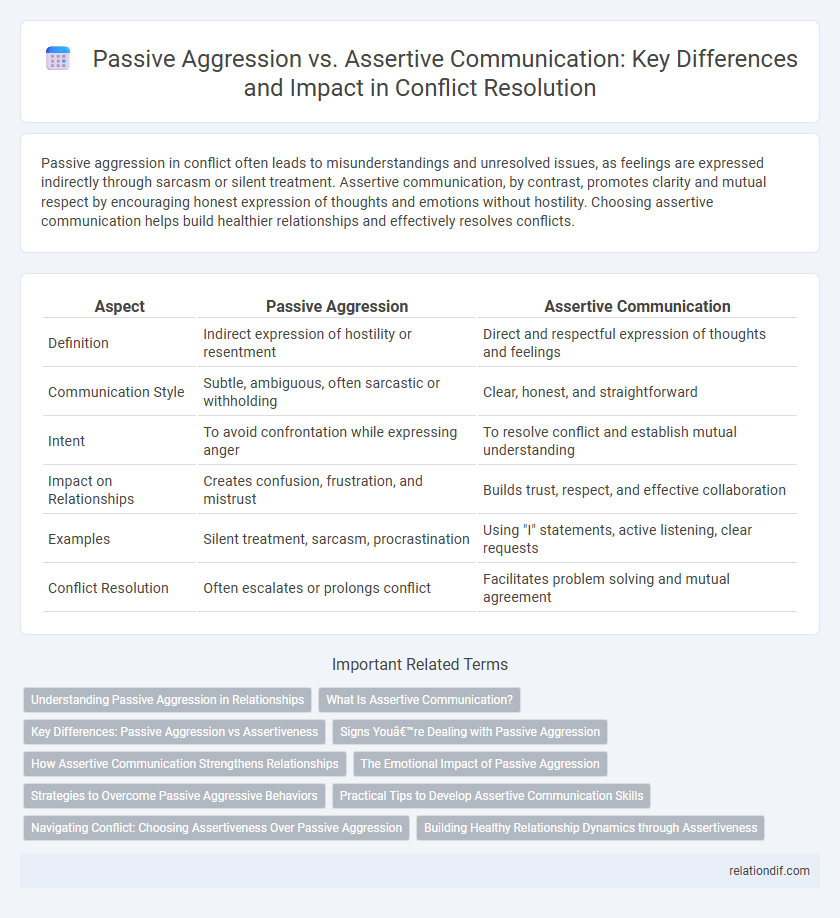Passive aggression in conflict often leads to misunderstandings and unresolved issues, as feelings are expressed indirectly through sarcasm or silent treatment. Assertive communication, by contrast, promotes clarity and mutual respect by encouraging honest expression of thoughts and emotions without hostility. Choosing assertive communication helps build healthier relationships and effectively resolves conflicts.
Table of Comparison
| Aspect | Passive Aggression | Assertive Communication |
|---|---|---|
| Definition | Indirect expression of hostility or resentment | Direct and respectful expression of thoughts and feelings |
| Communication Style | Subtle, ambiguous, often sarcastic or withholding | Clear, honest, and straightforward |
| Intent | To avoid confrontation while expressing anger | To resolve conflict and establish mutual understanding |
| Impact on Relationships | Creates confusion, frustration, and mistrust | Builds trust, respect, and effective collaboration |
| Examples | Silent treatment, sarcasm, procrastination | Using "I" statements, active listening, clear requests |
| Conflict Resolution | Often escalates or prolongs conflict | Facilitates problem solving and mutual agreement |
Understanding Passive Aggression in Relationships
Passive aggression in relationships often manifests through indirect expressions of hostility, such as sarcasm, procrastination, or silent treatment, which undermine open communication. Recognizing these behaviors is crucial, as they create confusion and resentment, preventing the resolution of underlying conflicts. Understanding passive aggression enables partners to shift toward assertive communication, fostering clearer expectations and healthier interactions.
What Is Assertive Communication?
Assertive communication involves expressing thoughts, feelings, and needs openly and respectfully while maintaining self-confidence and consideration for others. It promotes clear, direct dialogue that reduces misunderstandings and prevents escalation typical in passive aggression. Employing assertive communication strengthens relationships by fostering mutual respect and effective conflict resolution.
Key Differences: Passive Aggression vs Assertiveness
Passive aggression involves indirect resistance and covert hostility, often expressed through sarcasm, procrastination, or silent treatment, which undermines trust and hinders resolution. Assertive communication clearly conveys feelings and needs with respect, using direct, honest dialogue that fosters mutual understanding and effective conflict resolution. Key differences lie in the intent and clarity of expression--passive aggression masks true emotions to avoid confrontation, while assertiveness openly addresses issues to promote cooperation.
Signs You’re Dealing with Passive Aggression
Signs you're dealing with passive aggression include indirect resistance, such as procrastination or intentional inefficiency, and subtle expressions of resentment like sarcasm or backhanded compliments. Victims often notice a pattern of avoidance in addressing issues directly, with hostile feelings masked by seemingly cooperative behavior. This communication style undermines trust and prolongs conflict by preventing honest dialogue and resolution.
How Assertive Communication Strengthens Relationships
Assertive communication strengthens relationships by promoting clear, honest expression of feelings and needs, which reduces misunderstandings and builds trust. Unlike passive aggression, assertiveness encourages mutual respect and open dialogue, fostering a supportive environment where conflicts are resolved constructively. Consistent assertive interactions improve emotional connection and collaboration, enhancing overall relationship satisfaction.
The Emotional Impact of Passive Aggression
Passive aggression often leads to confusion, frustration, and resentment as the underlying emotions remain unaddressed and unexpressed directly. This covert form of hostility can erode trust and damage relationships by creating emotional distance between individuals. Emotional exhaustion is common for both the passive-aggressive person and the recipient, as the cycle of indirect communication perpetuates unresolved conflict.
Strategies to Overcome Passive Aggressive Behaviors
Strategies to overcome passive-aggressive behaviors include practicing direct, clear communication and setting firm boundaries to address underlying issues effectively. Encouraging open dialogue and expressing emotions honestly reduces misunderstandings and builds trust in conflict resolution. Implementing assertive communication techniques helps transform passive aggression into constructive problem-solving.
Practical Tips to Develop Assertive Communication Skills
Developing assertive communication skills involves clearly expressing your thoughts and feelings while respecting others' rights and boundaries. Practical tips include using "I" statements to own your emotions, maintaining steady eye contact to convey confidence, and practicing active listening to ensure mutual understanding during conflicts. Regularly rehearsing these techniques in low-stress situations enhances your ability to manage passive aggression and fosters healthier, more direct interactions.
Navigating Conflict: Choosing Assertiveness Over Passive Aggression
Navigating conflict requires prioritizing assertive communication, which fosters clarity, mutual respect, and effective problem-solving, unlike passive aggression that leads to misunderstanding and resentment. Assertiveness empowers individuals to express their needs and boundaries directly, reducing tension and promoting healthier relationships. Research shows that assertive communication improves conflict resolution outcomes, enhancing emotional well-being and collaboration.
Building Healthy Relationship Dynamics through Assertiveness
Passive aggression undermines trust and creates hidden tensions that erode relationship stability. Assertive communication fosters open dialogue, clear boundaries, and mutual respect essential for healthy relationship dynamics. Emphasizing honest expression and active listening strengthens emotional connection and conflict resolution skills.
Passive Aggression vs Assertive Communication Infographic

 relationdif.com
relationdif.com